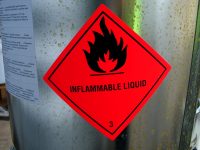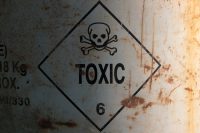Category: Chemicals
Today’s workplace uses thousands of chemicals, many of which are hazardous. The resources in this section will help guide you in the safe and legal identification, storage, transport, and use of these chemicals, and in making sure that your employees right to know how to be safe around such substances is provided, as required by law.
For employers that handle small quantities of highly hazardous chemicals or large quantities of flammable liquids or gases, the Occupational Safety and Health Administration’s (OSHA) process safety management (PSM) standard (29 CFR 1910.119) imposes extensive requirements on the handling of those substances. Until July 2015, many employers were avoiding the need to comply with those […]
Under the Occupational Safety and Health Administration’s (OSHA) revised Flammable Liquids standard (29 CFR 1910.106), every chemical with a flash point below 199.4°F (93°C) is flammable; the word “combustible” is no longer used. But, as before, some chemicals are more flammable than others, and storage and handling requirements are defined by flash point and boiling […]
A chemical that meets the definition of “flammable” requires special precautions in handling, use, transfer, and storage. But the Occupational Safety and Health Administration (OSHA) has changed the definition of “flammable” throughout its general industry and construction standards to align them with the Globally Harmonized System of Classification and Labelling of Chemicals (GHS). Most employers […]
Your workers have completed their medical evaluations and have been fit-tested; they know how to don and doff their respirators, how to keep them clean, and when to replace them. But do your workers know how their personal choices can impact safety when they’re wearing a respirator? Or do they just think they know? Workers […]
The U.S. Environmental Protection Agency (EPA), the Occupational Safety and Health Administration (OSHA), and a number of states and organizations are calling on businesses to take part in efforts to develop, buy, and use greener products. Today we will review some of these efforts. Do you need a particulate respirator, a gas/vapor respirator, or a […]
Along the way, you can take a look at some fun facts and trivia about bees, provided by Pennsylvania Apiculture Inc., the nonprofit that runs National Honey Bee Day. Label Requirements Registrants of certain pesticides that have been deemed harmful to bees are required to include instructions on the labels to applicators on minimizing exposure […]
OSHA and the National Institute for Occupational Safety and Health (NIOSH) recently issued a joint hazard alert about protecting workers from significant crystalline silica exposure during manufacturing, finishing, and installing natural and manufactured stone countertops. Protect workers in this and other industries from silica exposure with the safety measures outlined below. Preventing Silica Exposures Because […]
Each year, more than 300 American workers die from silicosis, and thousands of new cases are diagnosed. Silicosis is the name given to incurable lung damage that occurs when workers inhale dusts that contain crystalline silica. Silica comes in different forms, but crystalline silica is the type that causes scarring in the lungs. Crystalline silica […]
Recap: What Is Section 8(e)? TSCA Section 8(e) is a single short paragraph that has been the source of widespread confusion since TSCA became law in 1976. Section 8(e) simply states that U.S. chemical manufacturers (including importers), processors, and distributors must notify the EPA within 30 days of obtaining information that reasonably supports the conclusion […]
Recap: What are Nanoscale Materials? Nanomaterials are chemical substances that have structures with dimensions at the nanoscale—approximately 1 to 100 nanometers. To get an idea of their size, a human hair is approximately 80,000 to 100,000 nanometers wide. These materials are currently used in hundreds of consumer products, including electronics, cosmetics, clothing, food, and medicines. […]










